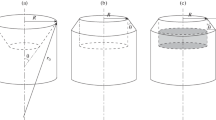Abstract
The analytical compound model of a magneto-electro-elastic wedge-junction structure simultaneously combines a bimaterial magneto-electro-elastic wedge and a three-material electromagnetic junction. This model gives special consideration to the electrostatic and magnetostatic fields in air. Based on the author’s previous study, new results of antiplane singularity orders at the apex of this wedge-junction structure have been obtained in this paper. The characteristic equation and numerical results are obtained for discussions. As a result, the existence of the air plays an important role to reduce the singularity when the permittivity or permeability of the solid approaches that of the air. This wedge-junction compound model is more realistic and shows the important roles of the electrostatic and magnetostatic fields in the air.
Similar content being viewed by others
References
Van Suchtelen J. (1972). Product properties: a new application of composite materials. Philips Res. Repts. 27: 28–37
Van Den Boomgaard J., Terrell D.R., Born R.A.J. and Giller H.F.J.I. (1974). An in situ grown eutectic magnetoelectric composite material. Part I: Composition and unidirectional solidification. J. Mater. Sci. 9: 1705–1709
Van Run A.M.J.G., Terrell D.R. and Scholing J.H. (1974). An in situ grown eutectic magnetoelectric composite material. Part II: Physical properties.. J. Mater. Sci. 9: 1710–1714
Echigoya J., Hayashi S. and Obi Y. (2000). Directional solidification and interface structure of BaTiO3–CoFe2 O4 eutectic. J. Mater. Sci. 35: 5587–5591
Zheng H. (2004). Multiferroic BaTiO3–CoFe2O4 nanostructures. Science 303: 661–663
Nan C.W. (1994). Magnetoelectric effect in composites of piezoelectric and piezomagnetic phases. Phys. Rew. B 50(9): 6082–6088
Song Z.F. and Sih G.C. (2003). Crack initiation behavior in magnetoelectroelastic composite under in-plane deformation. Theor. Appl. Fract. Mech. 39: 189–207
Spyropoulos C.P., Sih G.C. and Song Z.F. (2003). Magnetoelectroelastic composite with poling parallel to plane of line crack under out-of-plane deformation. Theor. Appl. Fract. Mech. 39: 281–289
Chue C.H. and Liu T.J.C. (2005). Magneto-electro-elastic antiplane analysis of a bimaterial BaTiO3–CoFe2O4 composite wedge with an interface crack. Theor. Appl. Fract. Mech. 44: 275–296
Wang B.L., Zhang H.Y. and Han J.C. (2007). A periodic array of cracks in a transversely isotropic magnetoelectroelastic material. Arch. Appl. Mech. 77: 541–558
Gao C.F., Tong P. and Zhang T.Y. (2003). Interfacial crack problems in magnetoelectroelastic solids. Int. J. Eng. Sci. 41: 2105–2121
Zhao M.H., Yang F. and Liu T. (2006). Analysis of a penny-shaped crack in a magneto-electro-elastic medium. Philos. Mag. 86: 4397–4416
Wang B.L. and Mai Y.W. (2003). Crack tip field in piezoelectric/piezomagnetic media. Eur. J. Mech. A 22: 591–602
Liu T.J.C. and Chue C.H. (2006). On the singularities in a bimaterial magneto-electro-elastic composite wedge under antiplane deformation. Compos. Struct. 72: 254–265
Sue W.C., Liou J.Y. and Sung J.C. (2007). Investigation of the stress singularity of a magnetoelectroelastic bonded antiplane wedge. Appl. Math. Model. 31: 2313–2331
Williams M.L. (1952). Stress singularities resulting from various boundary conditions in angular corners of plates in tension. J. Appl. Mech. ASME 19: 526–528
Bogy D.B. (1968). Edge-bonded dissimilar orthogonal elastic wedges under normal and shear loading. J. Appl. Mech. ASME 35: 460–466
Hein V.L. and Erdogan F. (1971). Stress singularities in a two-material wedge. Int. J. Fract. Mech. 7: 317–330
Ma C.C. and Hour B.L. (1989). Analysis of dissimilar anisotropic wedges subjected to antiplane shear deformation. Int. J. Solids Struct. 25: 1295–1309
Chue C.H. and Chen C.D. (2003). Antiplane stress singularities in a bonded bimaterial piezoelectric wedge. Arch. Appl. Mech. 72: 673–685
Chen C.D. and Chue C.H. (2003). Singular electro-mechanical fields near the apex of a piezoelectric bonded wedge under antiplane shear. Int. J. Solids Struct. 40: 6513–6526
Liu T.J.C., Chen C.D. and Chue C.H. (2006). Discussion of antiplane singularities of piezoelectric–dielectric and piezoelectric–conductor wedges. Arch. Appl. Mech. 76: 245–248
Pageau S.S., Joseph P.F. and Biggers S.B. (1994). The order of stress singularities for bonded and disbonded three-material junctions. Int. J. Solids Struct. 31: 2979–2997
Chen H.P. (1998). Stress singularities in anisotropic multi-material wedges and junctions. Int. J. Solids Struct. 35: 1057–1073
Chen M.C., Zhu J.J. and Sze K.Y. (2006). Electroelastic singularities in piezoelectric–elastic wedges and junctions. Eng. Fract. Mech. 73: 855–868
Wigger H.M. and Becker W. (2005). Inplane stress singularities at the interface corner of a bimaterial junction. Compos. Struct. 69: 193–199
Uchino K. (1997). Piezoelectric Actuators and Ultrasonic Motors. Kluwer, Boston
Ikeda T. (1990). Fundamentals of Piezoelectricity. Oxford University Press, New York
Sneddon I.N. (1972). The Use of Integral Transforms. McGraw-Hill, New York
Author information
Authors and Affiliations
Corresponding author
Rights and permissions
About this article
Cite this article
Liu, T.JC. The singularity problem of the magneto-electro-elastic wedge-junction structure with consideration of the air effect. Arch Appl Mech 79, 377–393 (2009). https://doi.org/10.1007/s00419-008-0240-7
Received:
Accepted:
Published:
Issue Date:
DOI: https://doi.org/10.1007/s00419-008-0240-7



